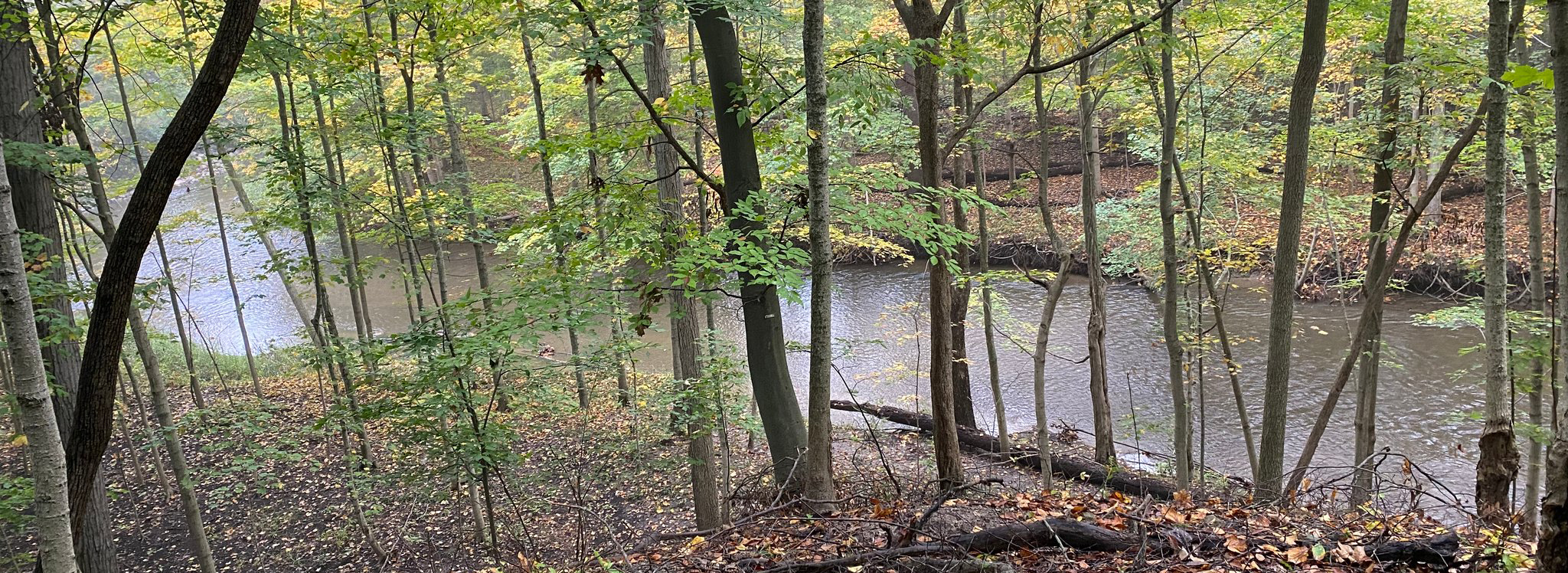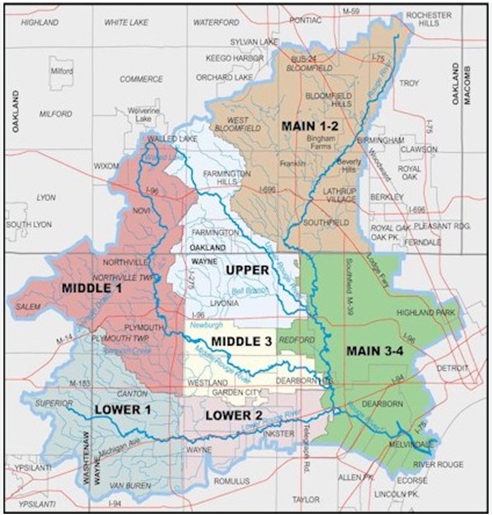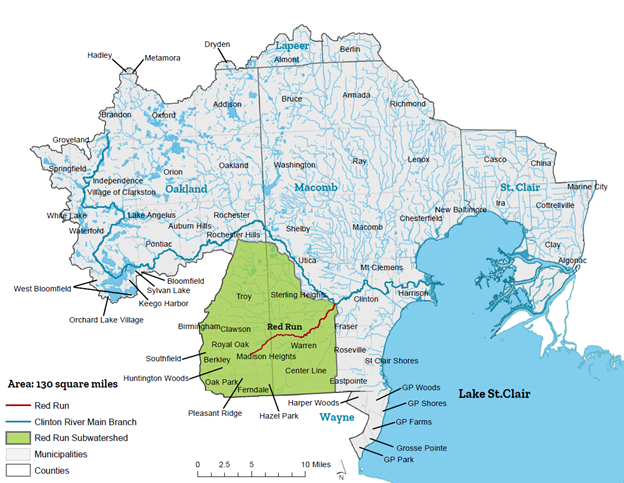Rouge River Watershed
Approximately ninety percent of the City of Southfield is located in the Rouge River Watershed which consists of four major sub-watershed branches: the Main, Upper, Middle, and Lower. The Rouge River Watershed is comprised of 467 square miles and impacting 47 communities that ultimately drains to the Detroit River. The City of Southfield belongs to the Main 1-2 sub-watershed comprising of 26.2 miles of river.
Clinton River Watershed
A small portion of the eastern side of the City of Southfield belongs to the Clinton River Watershed. The Clinton River Watershed consists of 760 square miles of lakes, ponds, wetlands, streams, and tributaries across four counties and 71 communities. The Clinton River Watershed consists of several sub-watersheds: Clinton Main, Clinton River East, Lake St. Clair, North Branch, Red Run, Stony Paint Creek, and Upper Clinton. The eastern portion of the City of Southfield belongs to the Red Run sub-watershed.
How do you impact the watershed?
Individuals are a major polluter to nearby rivers, lakes, and streams. The major pollutant source is called polluted stormwater. Stormwater is the water that runs over the ground during a rainstorm or snow melt. This stormwater picks up pollutants found in fertilizers, pesticides, oil and grease from cars and bacteria from pet wastes and waterfowl. The polluted stormwater enters the river directly or through storm drains that lead to the river. Everyone’s actions has the potential to either pollute the water or help restore its health.
What watershed do you live in?
A watershed is made up of the land area that drains to a specific body of water, such as a tributary, stream or river. If you live in Southfield, you live in the Rouge River Watershed or the Clinton River Watershed.
What is stormwater?
Stormwater is the rainfall or snowmelt that flows over our yards, streets, parking lots, and buildings and either enters the storm drain system or runs directly into a lake or stream.
What is a storm drain?
Storm drains are the openings you see along curbs and in streets and parking lots. They carry away rainwater and snowmelt and transport it through the system to nearby lakes and streams. Water and other debris that enter storm drains do not go to a treatment facility.
What is a sanitary sewer?
A sanitary sewer takes household water and waste from toilets, sinks, and showers, and transports it to a wastewater treatment facility. The water is treated and then discharged back to a lake or stream.
How does stormwater get polluted?
As stormwater flows over our lawns and driveways, it picks up fertilizers, oil, chemicals, grass clippings, litter, pet waste, and anything else in its path. The storm drain system then transports these pollutants, now in the water, to local lakes and streams. Anything that goes into a storm drain eventually ends up in a lake or stream.
Trees & Green Space
Trees
Trees make life possible on this planet for humans, wildlife, and other plants. From the oxygen we breathe to the houses we build, trees are a critical natural resource to us. From a stormwater perspective, trees soak up excess runoff through their root systems and their canopies capture falling rainwater. Unfortunately, human activity has harmed the tree population by exploiting resources, using harmful chemicals, destroying habitats, and ultimately preventing biodiversity of plants and animals from thriving.
Biodiversity is the variety of living things on this planet. According to the Arbor Day Foundation, “Biological diversity is essential to the health and wellness of our planet and all the plants, animals, and humans who share it. Ecosystems with higher levels of biodiversity have superior air and water quality, are more resistant to drought and disease, produce higher food-yields, and even contribute to the development of new and improved medicines.”
As of 2023, the City of Southfield has been recognized as a Tree City USA for 36 years by the Arbor Day Foundation. We take pride in this accomplishment and encourage all residents and property owners to help maintain and increase the City’s tree canopy by planting more trees!
Parks & Nature Preserves
The City of Southfield offers a variety of recreational opportunities through the parks and nature preserves available to residents and visitors. These parks and nature preserve are critical to the City as they are an outlet for people to exercise, socialize, and connect with nature.
Forest bathing is a practice known for immersing yourself in nature and connecting with your natural surroundings. The origins of forest bathing are traced to Japan in a practice known as shinrin-yoku, which means bathing in the forest atmosphere. What makes forest bathing a unique experience? The purpose of forest bathing is to disconnect from your daily life and enjoy the forest by soaking in the sights, listening to the peaceful surroundings, and inhaling fresh air. You can practice forest bathing in any season and in group settings regardless of your age and fitness level.
The City of Southfield has many parks and nature preserves where you can unwind, relax, and immerse yourself in nature. For the complete list of park locations, please visit the Park Locations page on the Parks & Recreation Department website.
Protecting and Enhancing Our Natural Resources through Policy
Over the years, the City of Southfield has implemented and updated policy to reflect best practices with regards to environmental and natural resource protection. These ordinances were created to protect trees, wetlands, and sources of water in addition to encouraging the implementation of green infrastructure and low impact development.
- Landscaping Ordinance
- Sanitary Sewer Ordinance
- Soil Erosion and Sedimentation Control Ordinance
- Stormwater Management and Water Quality Ordinance
- Wetland and Watercourse Protection Ordinance
- Woodlands and Tree Preservation Ordinance


